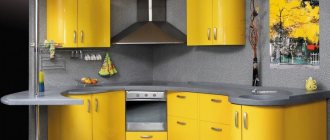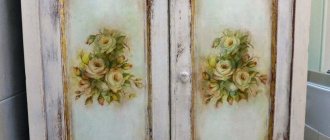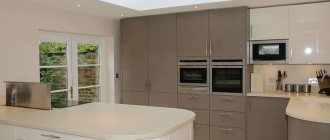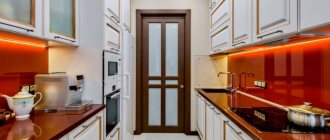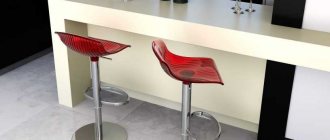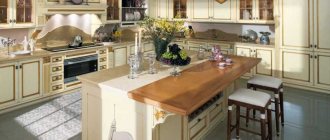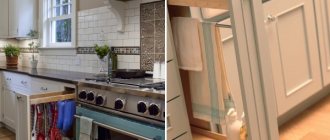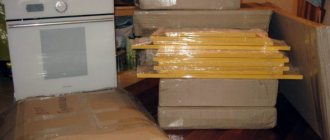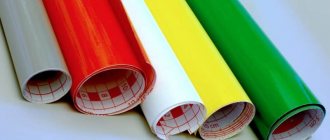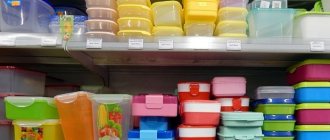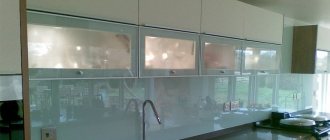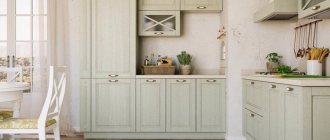Material for kitchen facade
The following materials are used for the arrangement:
- laminated chipboard;
- MDF;
- tree;
- frame;
- aluminum profile.
If everything is clear with wood or aluminum, then the abbreviations LDSP and MDF raise questions for many. These materials are widely used in modern furniture production.
The creation of materials such as laminated chipboard and MDF makes it possible to develop a wide range of products for the home, including the kitchen. Which is better: MDF or chipboard?
The kitchen needs furniture to withstand temperature fluctuations and high humidity. Cabinet doors are constantly subject to mechanical stress; they are opened with wet hands. Therefore, the façade of a kitchen unit is usually made of MDF, and the side walls and shelves are made of laminated chipboard. This is due to the characteristics of the materials.
How is MDF made? How to define quality?
To produce MDF, wood is crushed, dried and pressed.
Lignite, a natural substance found in wood, binds wood particles together instead of resins. There are practically no formaldehydes in MDF, and in terms of chemical safety the material is as close as possible to natural wood. For protection, PVC film, veneer or enamel is applied to it. The photo below shows the EGGER chipboard we use in production:
What are chipboard and MDF?
LDSP is laminated chipboard. It is obtained by pressing sawdust. But first they are treated with formaldehyde resin. Then it is laminated - covered with paper film impregnated with melamine resin. Paraffin or its emulsion makes laminated chipboard waterproof.
The predecessor of chipboard appeared in the 40s of the last century. To finish it, not only lamination is used, but also plastic, veneer, acrylic and even artificial stone.
MDF is a wood fiber board obtained by pressing dried wood chips. Before this, paraffin is added to it. They make the material durable. The sawdust used to produce MDF is very fine. Therefore, the product obtained from it is much stronger and denser. There are not many resins in such products that are harmful to humans. Such a stove appeared in the 60s of the last century.
So which is better, MDF or chipboard for the kitchen?
How to distinguish MDF from chipboard?
First, let's figure out how these names are deciphered. MDF is a fine wood fraction, and chipboard is a laminated chipboard. Both are made from wood waste, but the properties of these materials are different. Chipboard is made from larger chips. Therefore, to distinguish it from MDF, it is enough to look at the cut and pay attention to the structure. If you clearly see sawdust there, you have chipboard in front of you.
Advantages of waterproof laminated chipboard
Perhaps its main advantage is the low cost of chipboard. The price of a sheet ranges from 220 to 400 rubles. It depends on the thickness, which can be from 8 to 25 millimeters.
Products made from this material can withstand humidity and high temperatures, which are often encountered in the kitchen with chipboard furniture.
The price also depends on the type of decor.
The color range of LDPS products is quite wide. Often it repeats the colors of wood of different species.
So how to choose the material for your furniture?
Here is our memo in the form of simple theses:
- Laminated chipboard is perfect for the living room and hallway. Just make sure that the stove is of high quality. Request a certificate confirming the class of the slab.
- The combination of chipboard and MDF is suitable for children's bedrooms and bedrooms, but the rule is the same: the material must be of high quality, and the product must be well glued, including edges and joints.
- For the kitchen and bathroom, it is better to choose MDF: in these rooms it is most often exposed to changes in temperature and humidity.
Disadvantages of laminated chipboard
Firstly, it is rigid, due to which it cannot be milled.
Due to the presence of various resins, laminated chipboard is a toxic material. This indicator depends on what kind of resin was used in its manufacture. The least harmful substances are found in class E1 slabs.
Nevertheless, even countertops are made from laminated chipboard. Laminated chipboards are covered with HPL plastic, which is also called laminate, using postforming technology. Particular attention is paid to the quality of seams. If it is bad, then moisture gets into the sawdust, the tabletop board swells and loses all its qualities. Chipboard countertops are often not of very high quality.
What are the disadvantages of the material
Before you buy a laminated chipboard kitchen and start assembling it yourself or by a craftsman, think about whether it’s worth taking it.
After all, the material has a number of disadvantages. Now we will find out how significant and fair they are.
- Low moisture resistance
. Controversial point. The question here is which chipboard is best for the kitchen. After all, we are talking about high humidity here. Regular laminated chipboard will not hold up. But the moisture-resistant one will cope with its tasks quite well. Plus, the chips are covered by a laminating layer. It seals the slab, and therefore provides complete protection. Just make sure that the letter B is present in the material marking; - Weak ends and edges
. Allegedly, moisture still penetrates through them, and the chipboard begins to swell. Also a controversial minus. After all, there are different edges. For example, melamine tapes are often used in ordinary furniture. They are not suitable for the kitchen. But there are PVC edges. There are no complaints about them. Durable, thick, with good protective properties; - Simplicity of appearance
. Allegedly, laminated chipboard looks simpler and cheaper compared to natural materials. First of all, it's logical. It makes sense to buy expensive material if in appearance and properties it is in no way inferior to cheap laminated chipboard. Secondly, now the level of decor has increased. It’s not for nothing that I wrote this down as one of my advantages. It just depends on the specific manufacturer; - Fine processing
. This is already an objective shortcoming. Laminated chipboard is not suitable for fine processing. That is, threaded elements, milling and shaped notches cannot be made here. Therefore, such facades are usually straight and stand out due to their color. Another question is how important it is for the client to do the milling. After all, additional recesses complicate the process of maintenance and cleaning.
What am I getting at? Moreover, the merits of laminated chipboard are unfairly belittled. But the seriousness of the shortcomings is clearly exaggerated.
Advantages of MDF
The material is easy to process using milling tools. The result is a patterned relief surface.
PVC film in various colors can give furniture a modern and stylish look. She is not afraid of the effects of acids and household chemicals. Various enamels are used for finishing furniture.
Products made from MDF are fire resistant. They do not swell from moisture. We can say that the material’s characteristics are much closer to wood than chipboard. The kitchen surface is MDF (glossy) beautiful and original. The use of special effects (mother of pearl, chameleon) makes it possible to obtain beautiful and original products. And if we take into account the availability of all kinds of colors, then manufacturers have ample opportunities to create beautiful and original products for the kitchen.
Interesting solution: MDF instead of tiles
Traditional options for finishing the apron of the work area in the kitchen have long lost their relevance. Increasingly, designers are using unexpected materials to decorate this part of the wall: here there is metal, solid wood, and glass. Instead of tiles, MDF is increasingly being used. In the photo you can see that design ideas have transformed the usual wood fiber panels.
Looks nice, doesn't it?
If we compare MDF with the usual tiles, the latter will be more practical and easier to maintain, since it is still more resistant to water and detergents. But the cost and complexity of laying tiles sometimes help make a choice in favor of MDF, while the design of the panels allows you to choose options for any interior style.
MDF panels for the wall of the work area can be standard ─ with a wood pattern, finished with plastic, veneer elements or film. Glossy painted boards are widely used. You can paint and varnish an ordinary sheet of material, thereby giving it an individual design that matches the interior of your kitchen. Manufacturers' catalogs often contain photos of ready-made MDF kitchen aprons with printed images.
It’s easy to install MDF panels on an apron instead of tiles yourself; sometimes it’s enough to watch video instructions and master classes, which are easy to find on the websites of manufacturers and experienced craftsmen.
MDF with enamel
Very impressive products can be obtained by decorating MDF products with enamel of various colors. First, the surface is primed, painted, dried, and sanded. The next layer is applied, then several more.
After processing the last layer, the surface is varnished. After drying, polish again.
The advantage is its beautiful appearance, the disadvantage is that it is expensive compared to plastic or film coating. Such furniture can fade in the sun, leaving fingerprints on it. The back of the doors is usually white. In addition, mechanical shocks cause chips that cannot be repaired.
MDF or chipboard. What to choose when we go to order furniture?
Of course, you need to balance your desires with your capabilities. There can be no clear advice here. You need to thoroughly prepare for a trip to the salon: take at least an approximate measurement of the room; decide on the number of items you plan to purchase; look through pictures of finished interiors on the Internet (there are a great many of them now); indicate the amount you plan to meet and come to the nearest Mr.Doors furniture showroom at a time convenient for you.
Our experienced specialists will be happy to show you all the materials and components that we use to create furniture and tell you about the latest innovations in world furniture fashion. You will be able to touch everything, open/close it, and become a participant in the design of your future little cozy world.
What's better
So which is better: MDF or chipboard? For the kitchen, would it be nice to make all the furniture from MDF, and not just the facades? Yes, it would be stronger. But much more expensive. Therefore, this type of configuration is often used.
MDF has a higher density. This will not only extend the life of the products, but will also allow you to decorate them with various carved patterns and decorative ornaments.
The furniture created in this way has a beautiful appearance, the facade is indestructible. Of course, this furniture is not as durable as wooden furniture, but with normal care it will serve its owners faithfully for a couple of decades. And during this time, perhaps, new technologies will be created that will allow the production of higher quality furniture. The MDF kitchen gets different reviews. In general, consumers like the appearance, but are not satisfied with the quality of the countertop.
Types of finishing of MDF objects
The front side of the slab can have different finishes, which affects the strength and appearance of the product.
- Lamination with PVC film reliably protects the slab from moisture. This method is great for furniture in the kitchen, where items are often washed or opened with wet hands, or they may simply get water from dishes or other utensils.
- A thin layer of wood can be glued onto the surface, this is called veneer finishing. The items have a natural beautiful appearance, but the material will be too fragile, so mechanical damage should be avoided.
- Also, high resistance to humidity is formed by a layer of varnish that is applied to the surface. Therefore, objects with such a coating are resistant to high temperatures, which is typical for kitchens. The disadvantage is that touches may be imprinted on the surface or stains from the products may appear.
Differences
What is the difference? A facade based on chipboard for a kitchen is less profitable than MDF.
MDF facades are:
- painted;
- with plastic coating.
A veneered façade is an MDF base coated with a thin layer of wood from the catalog and coated with varnish, matte or glossy.
In terms of technical characteristics, it is inferior to a painted facade, but at the same cost. It is necessary to apply veneer on both sides. In this case, its technical dimensions are preserved.
Applying veneer on one side is cheaper. But then, during operation, after 1-2 years the facade may bend. A well-painted façade is not cheap. Can be painted on either one or both sides . This does not affect its functionality and technical characteristics.
Today, facing brick is very popular when decorating the facade of a house. Here are its dimensions.
For finishing putty for painting, a special mixture is used. Here's all about the types of finishing putty.
Crushed stone is produced by crushing rocks into fractions larger than 5 mm. By clicking on the link you can familiarize yourself with crushed stone GOST 8267 93.
Plastic application of a millimeter layer in a variety of colors is the most common type of order. Plastic must also be applied on both sides. This façade can be mounted in different aluminum frames and with rounded ends. It is convenient and beautiful to cover MDF with PVC film.
If you apply plastic to MDF on only one side, the panel may also become deformed over time. The aluminum frame protects the inside of the MDF from water and moisture. This significantly increases the life of the furniture. In addition, such coatings are easy to clean and last a long time.
The most reliable facades made of MDF are those with plastic applied in an aluminum frame facade . Here about the MDF profile for frame facades. There is a wide range of color solutions - up to 500.
For more information about the differences between MDF and chipboard, watch the video:
